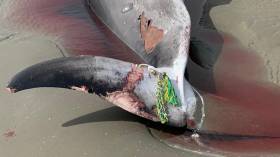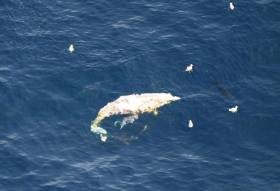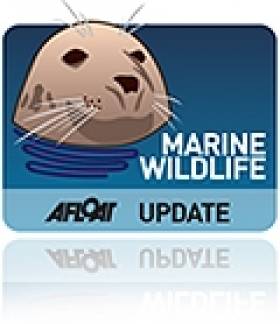Displaying items by tag: minke whales
Iceland Set to Halt Commercial Whaling From 2024
Falling demand for whale meat has prompted Iceland to announce and end to commercial whaling from 2024, as RTÉ News reports.
The move will leave Norway and Japan as the only countries that hunt whales for commercial purposes.
In an article published in the Morgunbladid newspaper, Icelandic fisheries minister Svandis Svavarsdottir said: “There is little proof that there is any economic advantage to this activity.”
Despite having sizeable annual quotas for minke and fin whales, neither of Iceland’s two main licence holders have hunted whales for a full season since 2018 — and only one has been killed in the past three years.
Meanwhile, among other issues affecting exports, Japan’s resumption of whaling has all but eliminated demand for such meat from the Icelandic fishery.
Iceland’s relationship with the whales in its waters was documented in a 2020 film that followed an Irish Whale and Dolphin Group expedition in search of humpback whales, as previously reported on Afloat.ie.
A sea angler got more than he bargained for last week when he was thrown from his boat by a whale while fishing off West Cork.
As CorkBeo reports, Cris Lane was angling with friend Dave McCann off Courmacsherry last Monday (3 August) when they noticed a bounty of marine wildlife — both dolphins and small whales — close by, and their vessel was bumped by a passing minke whale.
The hit was enough to send Lane flying overboard — but thanks to his lifejacket keeping him buoyant, he was able to quickly get out of the cold water and back on board.
CorkBeo has much more on the story HERE.
Dead Minke Whale Washed Ashore In Co Down
The public has been urged to “stay clear” of a minke whale carcass found washed up on Tyrella beach in Co Down yesterday morning (Monday 9 September).
According to ITV News, the 27ft marine wildlife giant was found with what appeared to be a piece of fishing gear wrapped around its tail — suggesting that it may have been caught up in a net off the coast.
Newcastle Coastguard attended the “distressing scene” on request by NI Fisheries Protection, said BBC News, which also noted that a similar whale carcass stranded in a Donegal estuary on Lough Swilly a month ago.
Minke Whales In Huge Numbers Off West Cork
#MarineWildlife - Galley Head was the place to see Ireland’s biggest recorded gathering of minke whales in recent weeks, as TheJournal.ie reports.
Cork Whale Watch skipper Colin Barnes estimated more than 50 minke whales feeding off the coast of West Cork on Sunday 29 April.
“It is remarkable how the month of April extending into May, which was once considered by us whale watchers to be low season for any species, is rapidly becoming one of the busiest times of the year,” said Pádraig Wholley, sightings officer with the Irish Whale and Dolphin Group (IWDG).
West Cork is also one of the best places in Ireland to see humpback whales, who can count marine wildlife specialist Emer Keaveney among their biggest fans.
The “ambassadors of the world’s oceans” are coming to Irish waters in increasing numbers, as Tom MacSweeney stated earlier today.
And they are also the subject of a groundbreaking expedition to Iceland this summer on board the IWDG’s research vessel Celtic Mist.
Elsewhere, the sighting of a dolphin attacking a porpoise off Scotland could point to increased competition over a food source.
As the Irish Examiner reports, dramatic images captured in the Moray Firth earlier this month were part of a series of ‘unusual’ sightings of bottlenose dolphin attacks.
Stranded Minke Whale Saved By Quick-Thinking Local Man In Co Down
#MarineWildlife - A retired coastguard volunteer has spoken of the “amazing” experience of helping a stranded whale to safety in Northern Ireland on Tuesday (3 October).
As BBC News reports, commercial diver John Lowry diverted from his commute home to the scene, on a sandbank near Newcastle promenade in Co Down, and immediately set to work.
“The first thing I did was to try and get the head of the whale pointed out to sea, so that if I could get him to move that he was going directly out to sea,” he said, explaining how minke whales are easily disoriented when stranded.
Lowry spent up to 15 minutes slowly and painstakingly urging the whale forward with each small wave — until finally it kicked into deeper water, much to the delight of locals and children who were watching the ordeal.
However, Lowry offered a word of caution for anyone else thinking of attempting a similar rescue.
“Don't approach [a whale] unless you have experience of this kind of thing, because they are very powerful,” said the Newcastle man, who previously helped save a beached whale when he served with South Down Coastguard.
In other news, a whale died in the waters between Ireland and Scotland coast after getting entangled in a rope — the first such recorded occurrence in 25 years.
According to Deadline News, the Northern Bottlenose whale — a species rarely sighted in the waters of the continental shelf — was found with wounds caused by rope, and is though to have drowned before it washed up at Ardentinny in Western Scotland in late September.
“Entanglement is known to be a global problem particularly for large whales,” says the Scottish Marine Stranding Scheme.
Rare Sight Of Large Minke Whale Pod In Irish Sea ‘Feeding Frenzy’
#MarineWildlife - An “extremely rare” pod of minke whales has been sighted in the Irish Sea off the Isle of Man this week.
According to BBC News, the pod comprising as many as 20 minke whales was engaged in a “feeding frenzy” as seen by members of Manx Whale and Dolphin Watch on Wednesday (13 September)
The marine wildlife species is a regular visitor to the waters around the Isle of Man, but sightings are usually of solitary adults or small pods.
It’s believed that spawning herring have attracted them in much greater numbers. BBC News has more on the story HERE.
In other marine wildlife news, the Irish Whale and Dolphin Group’s AGM takes place on Sunday 8 October at the Middle Country Café in Cloughjordan, Co Tipperary. Details are available from the IWDG website.
Ireland’s Whale Watching Season Is Expanding Says IWDG
#MarineWildlife - The Irish Whale and Dolphin Group’s Pádraig Whooley says he has “lost count” of the number of minke whales seen off West Cork in recent days, as The Irish Times reports.
Whales of various cetacean species are now arriving in Ireland in larger numbers much earlier in the year than their usual appearance in autumn, according to the IWDG’s sightings co-ordinator.
Minke whale numbers between Union Hall and Galley Head have been “exceptional” since last week, says Whooley — who also notes that a pod of humpbacks familiar to West Kerry coastal residents has been feeding off Cork over the past fortnight, while the whale known as Boomerang has been spotted off Waterford.
Elsewhere, the Air Corps Maritime Squadron recently captured some astonishing images of sharks feeding on a whale carcass some 200km northwest of Donegal.
“It's not often that we get sent such clear images of a dead cetacean being scavenged on by several sharks,” said IWDG standings officer Mick O'Connell, “but it does give an indication of the importance of dead animals in the food chain.”
Minke Whale Deaths Cause For Concern In Kerry
#MarineWildlife - A number of dead minke whales found off the Dingle Peninsula in recent months have puzzled locals and experts alike, as TheJournal.ie reports.
The carcasses of three juvenile minkes have been spotted in the region since April, comprising 25% of all Irish minke whale standings since records began in 2000.
A fourth whale carcass was found on the shore at Killough in Co Down last week, according to BBC News.
But no one seems to know the reasons for these marine wildlife deaths, with the lack of a post-mortem scheme for whale strandings making matters even cloudier.
Mick O’Connell, strandings co-ordinator of the Irish Whale and Dolphin Group (IWDG), believes the phenomenon is localised to the Dingle Bay area.
Yet while the species is a regular visitor to the Blasket Islands and environs, O'Connell says it's "very unusual to have so many dead ones in the one small area, in the space of 10 or 12 weeks."
The same region also saw a number of unsubstantiated dolphin deaths in recent weeks, which one fishery expert suggested might be connected with the presence of so-called 'supertrawlers' fishing in the area.
Similar concerns were raised earlier in the year when a spike in common dolphin standings, primarily in the North West – totalling 28 for January and February alone – coincided with reports of supertrawler activity off the Dongeal, Sligo and Mayo coasts.
Minke Whale Baby Boom off Scotland’s West Coast?
Sightings of juvenile minke whales off Scotland’s west coast increased in 2015 to the highest ever recorded within a survey season, during marine research expeditions carried out by Hebridean Whale and Dolphin Trust – indicating either a significant increase in actual numbers or an influx of minke whales from elsewhere.
The charity’s 2015 research season also recorded the highest annual number of common dolphin sightings since its expeditions began, with 723 individuals observed over 63 encounters. The common dolphin was once uncommon in the Hebrides, but the trust’s encounter rate with the species has more than doubled over the past 12 years, also for reasons that remain unclear.
Kerry Froud, Hebridean Whale and Dolphin Trust Biodiversity Officer, said: “These intriguing changes in Scotland’s marine life highlight the importance of long-term monitoring of cetaceans – so that we can better understand what is happening in our waters, and then make management recommendations to better protect this world-class area of marine biodiversity.”
The studies were carried out between May to October by scientists and volunteers on board Silurian, the trust’s dedicated research yacht. The research forms part of the trust’s unique long-term monitoring of whales, dolphins and porpoises – collectively known as cetaceans – in the Hebrides. Information on basking sharks is also collected during the surveys.
A steady increase in the encounter rate with minke whale juveniles since 2011 was particularly marked this year, with the highest rate of young whales recorded since the trust started boat-based surveys in 2003. The 2015 surveys documented an encounter rate of 1 young minke whale per 286 km – three times the average over the trust’s entire dataset.
The minke whale is the smallest of the baleen whales – species which utilise baleen plates rather than teeth to feed – in the North Atlantic, measuring up to 10 metres in length, and is the most commonly sighted baleen whale species in the UK. Hebridean Whale and Dolphin Trust holds an identification catalogue of 125 minke whales known to have visited the Hebrides – of which some individuals return to the same areas annually, while others may only be passing through.
While an increase in the encounter rate with young minke whales is encouraging, there are still very serious issues regarding the conservation of this migratory species. To the north of Scotland, both Iceland and Norway still hunt minke whales. It remains unknown whether or not the minke whales that swim through Scottish waters frequent the waters where they risk being hunted.
The record number of common dolphin sightings – coupled with the most northerly sighting of the species ever recorded in September this year, off Tromso in Norway – suggests that changes are underway within our seas and oceans. The causes, and wider effects on the marine environment and other species, are still unclear – underlining the importance of on-going research.
Additionally, the number of white-beaked dolphin encounters almost doubled in comparison to 2014, although many of these encounters were made during one particular day of survey around the Butt of Lewis. This rarer, colder water species is confined to the north Atlantic and prefers temperate to sub-Arctic waters – meaning that the warming of Hebridean seas, at a rate of 0.5°C per decade, is expected to exert increased pressure on the populations found off Scotland’s west coast.
White-beaked dolphins have been the focus of acoustic research by Hebridean Whale and Dolphin Trust, with a study in 2013 discovering that white beaked dolphin populations off the east and west coasts of Scotland have distinct acoustic signatures, almost like accents.
Alongside warming seas and climate change, human activities causing increasing stress on cetaceans and basking sharks include fisheries by-catch, pollution, underwater noise and habitat loss.
Cetacean entanglement in litter and fishing gear can cause mobility problems, injury and even death, and the trust is working cooperatively with the fishing industry and other researchers in the UK to better understand this problem so that it can be addressed. This year, ironically whilst the Silurian crew was celebrating a volunteer’s 60th birthday, a bunch of balloons was retrieved from the water – a reminder that celebratory balloons, even if marketed as ‘biodegradable’, can have lasting consequences for our wider environment.
Silurian – previously used in filming of the BBC’s The Blue Planet series – covered more than 4,000 nautical miles in 2015, its crew of volunteers and marine scientists documenting more than 1,200 encounters with cetaceans and basking sharks, and recording almost 625 hours of underwater detections of cetaceans using specialist listening equipment.
Despite less than favourable weather conditions, the overall encounter rate remained steady, with eight sightings of cetaceans per 100 km recorded, compared to nine per 100 km in 2014 and five per 100 km in 2013.
The annual surveys depend on paying volunteers. In 2015, 69 dedicated volunteers clocked up 760 survey hours – working with marine scientists to conduct visual surveys and acoustic monitoring with hydrophones (underwater microphones) monitored by computers, and identifying individual cetaceans through photography of dorsal fins.
The trust – based in Tobermory on the Isle of Mull – is recruiting volunteers for its 2016 surveys, to live and work as citizen scientists onboard Silurian for expeditions of one to two weeks from April to September. Participation costs cover boat expenses, support the trust’s research programme and include accommodation, training, food and insurance. For details, contact Morven Russell at [email protected], call 01688 302620, or visit www.hwdt.org.
Hebridean Whale and Dolphin Trust has been monitoring marine mega fauna in the Hebrides for 13 years, and is the only organisation collecting long-term data on such a large scale on Scotland’s west coast. A short film about its marine surveys is above.
Western Scotland’s seas are one of Europe’s most important habitats for cetaceans and one of the UK’s most biologically productive areas. So far 24 of the world’s 83 cetacean species have been recorded in the region, many being national and international conservation priority species.
Six Humpback Whales Surprise Small Sailboat
#MarineWildlife - The video above shows the shocking moment when a small boat of wildlife watchers was suddenly surrounded by six giant humpback whales.
As the Irish Mirror reports, the duo who captured this amazing footage were sailing in a Norwegian fjord when they saw the whales feeding on herring in the distance and decided to move closer for a better look.
But little did they imagine how close they would get!
Thankfully for the pair, their boat was barely rocked on the waves as the marine giants deftly manoeuvred around them.
"I felt very confident afterwards," said Svein Aasjord, one of the two sailors. "Whales have much more control than I had thought."
Although Irish whale watchers might not be treated to such sights in close quarters, the Northwest is currently a treat for anyone who wants to see minke whales in action.
The Irish Whale and Dolphin Group reports on what's become a trend for the species wintering off the Donegal coast between Bun on Inver and Bloody Foreland.
As many as six min whales were spotted in inshore waters within 200 metres the latter location three days ago, due most likely to the bounty of herring in the area.































































